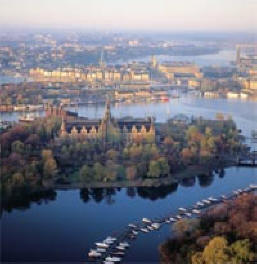|
||||||
|
Transportation
Traffic regulations
Sweden's road network is in good condition, including the northernmost parts of the country where the volume of traffic is fairly low. All European driving licences are valid. Vehicles not registered in Sweden must display a nationality sign. If you need emergency car repairs you may call the emergency services on 020 91 00 40. In Sweden you should observe the following: Dipped beam must always be used even in daylight. Safety belts must be used in both front and back seats. If safety belts have not been installed for all seats, you must use those seats that have belts as far as possible. Children under 7 must use special safety equipment such as baby protector, child seat, pad with belt or chair with belt. |
|
|
The alcohol limit is 0.2 grams per litre of blood. The police have the right to take alcohol tests by drivers blowing into a bag even if their is no suspicion of them being under the influence of alcohol.
The general speed limits are 50 km/h in urban areas, 70 km/h outside urban areas and 110 km/h on motorways. Other speed limits are always signposted by the roadside. Cars with caravans may not drive over 80 km/h. The car must be fitted with special rear-view mirrors. The speed limit for cars with trailers is 40 km/h if the total weight (or kerb weight when the trailer is not loaded) exceeds one sixth of the car's kerb weight. The trailer's gross weight must not exceed the gross weight of the car.
There are many wild animals in Sweden, particularly moose, roe deer and reindeer. Be extra cautious at dawn and dusk and observe the road signs. Around half of all car accidents in Sweden involve wild animals.
There are a lot of road works in the summer in Sweden. Reduce your speed and show consideration to the road workers. The Swedish National Road Administration has up-to-date information on road works on its website.
For all unattended, signposted pedestrian crossings, all vehicles are obliged to give way to pedestrians who are on, or about to use, the crossing, which means that the vehicle must stop and let the pedestrian cross.
You are allowed to use your mobile phone when driving (until further notice).
Transport of bikes
SJ has stopped transporting bikes and other freight. This service is now offered by the company Expressgods. You will find information on prices on their website (under the heading "priser" (prices)), unfortunately these can only be viewed in Swedish) where you can also find the opening hours and telephone numbers for the stations (under the heading "stationer och öppettider" stations and opening hours)). You can contact Central Station in Stockholm via e-mail or by telephone +46-8-762 2605, or +46 8-762 26 06, fax +46 8-762 26 40.
Transporting bikes from Germany to Sweden is possible via the stretch Berlin/Sassnitz/Trelleborg (price approx EUR 8). There is, however, no problem taking your bike on the ferries.
Cross-regional buses can sometimes transport your bike if you ask the bus driver; however, Swebus and Svenska Buss do not carry bikes. Transporting bikes on domestic flights costs around EUR 22.
Biking
Sweden offers a range of excellent facilities for cyclists. There are two bike paths that traverse the whole country: Sverigeleden (the National Route) and Cykelspåret (the Bike path). Sverigeleden takes you from south to north and from east to west, and includes 33 sections in total. The main stretch runs from Karesuando to Helsingborg in 14 sections, the remaining 19 are regional alternative stretches. A section might be anything from 15 to 400km long. You can also follow the bike path "Cykelspåret" along the coast from Ystad to Haparanda. Additionally, there are many regional bike paths that are often featured in special cycling brochures (available from tourist offices). Good cycling maps can be purchased here.
Biking along the North Sea coastline
The world's longest bike path connects seven countries around the North Sea: the Netherlands, Germany, Denmark, Sweden, Norway, Scotland and England. The Swedish stretch starts in Varberg and continues along the coast of Halland via Gothenburg and Bohus County up to the Norwegian border.
Riding rail trolleys
Riding rail trolleys is very popular in Sweden. You can cycle through fine countryside on disused railways! Most stretches can offer pedal rail trolleys which in principle operate as bikes although on a track, whereas some stretches have hand pump trolleys. A good tip is a tandem allowing you to rest a while as riding rail trolleys is not just fun, it is also a physical activity that will give you a real workout. |
|

